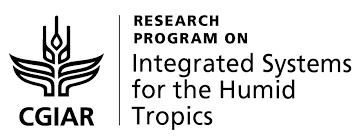Resultados de la búsqueda
Displaying 1 - 10 of 11 results.
Similarities Among FARA-Led IAR4D Innovation Platforms
Multi-stakeholder partnerships network which is typified by the FARA-led Integrated Agriculture Research for Development (IAR4D) of the SSA-Challenge Program is an innovation platform (IP) composed of stakeholders bound together by their individual interests in a shared commodity or outcome. The result from such innovation platforms is largely influenced by the strength of the network. In this paper, similarities within and across platforms are assessed using the simple matching procedure. Results indicate consistency in conduct of Innovation Platform activities.
Tema(s):
desarrollo de capacidades (DC)seguridad alimentaria y nutricionalevaluación de impactosistemas de innovacióninnovaciónplataformas de innovaciónaprendizajeprocesos de múltiples partes interesadasenfoques participativosinvestigacióninvestigación para el desarrollodesarrollo ruralagricultura sostenible...
Año de publicación:
2013Agricultural Innovation Platform As a Tool for Development Oriented Research: Lessons and Challenges in the Formation and Operationalization
This paper presents the processes, general guidelines lessons and experiences pertaining to “good practices” for organizing and forming Agricultural Innovation Platforms in the Lake Kivu Pilot Learning Site, covering three countries (Uganda, Rwanda and Democratic Republic of Congo) with widely differing social political environments to address agricultural development challenges.
Tema(s):
desarrollo de capacidades (DC)facilitaciónsistemas de innovaciónplataformas de innovaciónConocimientos localesaprendizajeaprendizaje institucionalmonitoreo y evaluación (MyE)procesos de múltiples partes interesadasenfoques participativosparticipación del sector privadoinvestigacióninvestigación para el desarrollocadenas de valorPequeños agricultores...
Año de publicación:
2011Agricultural Innovation in Sub-Saharan Africa. Experiences from multi-stakeholder approaches
This review seeks to assess the usefulness of innovation systems approaches in the context of the Integrated Agricultural Research for Development (IAR4D) in guiding research agendas, generating knowledge and use in improving food security and nutrition, reducing poverty and generating cash incomes for resource-poor farmers. The report draws on a range of case studies across sub-Saharan Africa to compare and contrast the reasons for success from which lessons can be learned.
Tema(s):
desarrollo de capacidades (DC)sistemas de innovacióninnovaciónsistemas de conocimiento e informaciónprocesos de múltiples partes interesadasinvestigación...
Año de publicación:
2012Approaches for setting-up multi-stakeholder platforms for agricultural research and development
In order to facilitate improved returns to research and development in African agriculture, the innovation systems approach which engenders the involvement of multiple stakeholders in its innovation pathway, has been proposed. Despite the potential of this approach, the understanding of its implementation and particularly of the process of setting up its multi-stakeholder platform is still largely lacking. Yet, this platform is critical to the success and sustainability of the operations of the platform.
Tema(s):
desarrollo de capacidades (DC)Herramientas del DCsistemas de innovacióninnovaciónplataformas de innovaciónprocesos de múltiples partes interesadasinvestigacióninvestigación y desarrollo (I + D)investigación para el desarrollodesarrollo rural...
Año de publicación:
2012Institutional Innovations for Building Impact-Oriented Agricultural Research, Knowledge and Development Institutions
This paper examines how the different institutional innovations arising from various permutations of linkages and interactions of ARD organizations (national, international advanced agricultural research centres and universities) influenced the different outcomes in addressing identified ARD problems.
Tema(s):
intermediacióndesarrollo de capacidades (DC)cambio climáticoeducaciónactividades de extensiónfacilitaciónigualdad de génerosistemas de innovacióninnovaciónplataformas de innovaciónTICaprendizaje institucionalprocesos de múltiples partes interesadasnegociaciónenfoques participativospolíticasparticipación del sector privadoparticipación del sector públicoinvestigacióninvestigación para el desarrollocadenas de valorPequeños agricultores...
Año de publicación:
2011Unlocking the Potential for Integrated Agricultural Research for Development in the Savanna of West Africa
This book documents the proof of the Integrated Agricultural Research for Development (IAR4D) Concept that was developed by the Forum for Agricultural Research for Development in Africa (FARA). The IAR4D concept forms the basis for the Sub Saharan Africa Challenge Program (SSA CP) which is the only CGIAR Challenge Program that was limited to only one region in the world.
Tema(s):
desarrollo de capacidades (DC)actividades de extensiónsistemas de innovacióninnovaciónplataformas de innovaciónaprendizajeinvestigacióninvestigación y desarrollo (I + D)investigación para el desarrollo...
Año de publicación:
2014Stakeholder Participation in Innovation Platform and Implications for Integrated Agricultural Research for Development (IAR4D)
In sub-Saharan Africa, there is increasing interest for the adaptation and use of the innovation systems approach to advance learning and development in the Agricultural Research and Development (ARD) sector. This crave is constrained by unavailability of a proven blue print that describe the paradigm shift from the linear approach and how such could function under different socio-economic, cultural and political climate.
Tema(s):
desarrollo de capacidades (DC)actividades de extensiónevaluación de impactosistemas de innovacióninnovaciónplataformas de innovaciónprocesos de múltiples partes interesadasredesenfoques participativospolíticasparticipación del sector privadoparticipación del sector públicoinvestigacióninvestigación participativainvestigación para el desarrollocadenas de valorPequeños agricultores...
Año de publicación:
2012Operationalisation of innovation platforms in the Lake Kivu pilot learning site
This chapter is a part of the book Integrated Agricultural Research for Development: from Concept to Practice. It focuses on the development and implementation of action plans for innovation platforms (IPs). The chapter introduces the constitution of committees, IP operationalisation, the case of IP functioning in the Democratic Republic of Congo, and post-formation issues for IPs.
Tema(s):
innovaciónplataformas de innovaciónaprendizajeprocesos de múltiples partes interesadasinvestigación para el desarrollo...
Año de publicación:
2013What does it Mean to Make a ‘Joint’ Decision? Unpacking Intra-household Decision Making in Agriculture: Implications for Policy and Practice
Research-based evidence on the adoption of climate-smart agricultural practices is vital to their effective uptake, continued use and wider diffusion. In addition, an enabling policy environment at the national and regional levels is necessary for this evidence to be used effectively. This chapter analyzes a 4-year period of continuous policy engagement in East Africa in an attempt to understand the role of multi-stakeholder platforms (MSPs) in facilitating an enabling policy environment for climate change adaptation and mitigation.
Tema(s):
cambio climáticopolíticas de innovaciónprocesos de múltiples partes interesadasenfoques participativos
Año de publicación:
2018Smoke, mirrors and poverty: communication, biotechnological innovation and development
Communication is essential to making biotechnology and genomics relevant to developing countries and poor people. Few would disagree with that. But many are sceptical about public relations efforts to impose inappropriate technological ‘solutions’ on developing countries. This paper is a partial reflection on how PR and advocacy ‘mixes’ can be understood and whether they can be useful to innovation in developing country contexts.
Tema(s):
abogacía/ promocióndesarrollo de capacidades (DC)comunicaciónsistemas de innovacióndesarrollo rural...
Año de publicación:
2005Páginas
Sorting block
Filtrar por idioma
Filtrar por tema(s)
- advocacy (1) Apply advocacy filter advocacy
- brokering (1) Apply brokering filter brokering
- capacity development (CD) (9) Apply capacity development (CD) filter capacity development (CD)
- climate change (2) Apply climate change filter climate change
- communication (1) Apply communication filter communication
- education (1) Apply education filter education
- extension (3) Apply extension filter extension
- facilitation (2) Apply facilitation filter facilitation
- food and nutrition security (1) Apply food and nutrition security filter food and nutrition security
- gender equality (1) Apply gender equality filter gender equality
- impact assessment (2) Apply impact assessment filter impact assessment
- innovation systems (11) Apply innovation systems filter innovation systems
- knowledge and information systems (4) Apply knowledge and information systems filter knowledge and information systems
- learning (6) Apply learning filter learning
- monitoring and evaluation (M&E) (1) Apply monitoring and evaluation (M&E) filter monitoring and evaluation (M&E)
- multi-stakeholder processes (8) Apply multi-stakeholder processes filter multi-stakeholder processes
- negotiation (1) Apply negotiation filter negotiation
- networks (2) Apply networks filter networks
- participatory approaches (5) Apply participatory approaches filter participatory approaches
- policies (2) Apply policies filter policies
- private sector engagement (3) Apply private sector engagement filter private sector engagement
- public sector engagement (2) Apply public sector engagement filter public sector engagement
- research (9) Apply research filter research
- rural development (3) Apply rural development filter rural development
- sustainable agriculture (1) Apply sustainable agriculture filter sustainable agriculture
- value chains (3) Apply value chains filter value chains
Filtrar por autor(es)
- (-) Remove Adekunle A. A. filter Adekunle A. A.Adekunle A. A.
- Africa Lead (8) Apply Africa Lead filter Africa Lead
- Agrinatura (31) Apply Agrinatura filter Agrinatura
- Asia-Pacific Association of Agricultural Research Institutions (APAARI) (9) Apply Asia-Pacific Association of Agricultural Research Institutions (APAARI) filter Asia-Pacific Association of Agricultural Research Institutions (APAARI)
- Asia-Pacific Islands Rural Advisory Services Network (APIRAS) (12) Apply Asia-Pacific Islands Rural Advisory Services Network (APIRAS) filter Asia-Pacific Islands Rural Advisory Services Network (APIRAS)
- CDAIS project (87) Apply CDAIS project filter CDAIS project
- Chowdhury A. (9) Apply Chowdhury A. filter Chowdhury A.
- Commission on Sustainable Agriculture Intensification (CoSAI) (17) Apply Commission on Sustainable Agriculture Intensification (CoSAI) filter Commission on Sustainable Agriculture Intensification (CoSAI)
- Dhehibi B. (9) Apply Dhehibi B. filter Dhehibi B.
- Dijkman J. (8) Apply Dijkman J. filter Dijkman J.
- Dror I. (24) Apply Dror I. filter Dror I.
- Ekong J. (8) Apply Ekong J. filter Ekong J.
- Fatunbi O. (15) Apply Fatunbi O. filter Fatunbi O.
- Food and Agriculture Organization of the United Nations (FAO) (103) Apply Food and Agriculture Organization of the United Nations (FAO) filter Food and Agriculture Organization of the United Nations (FAO)
- Food and Agriculture Organization of the United Nations ( FAO ) (54) Apply Food and Agriculture Organization of the United Nations ( FAO ) filter Food and Agriculture Organization of the United Nations ( FAO )
- Grovermann C. (8) Apply Grovermann C. filter Grovermann C.
- Hall, A. (24) Apply Hall, A. filter Hall, A.
- Hall A. (10) Apply Hall A. filter Hall A.
- Hoekstra D. (11) Apply Hoekstra D. filter Hoekstra D.
- International Fund for Agricultural Development (15) Apply International Fund for Agricultural Development filter International Fund for Agricultural Development
- International Fund for Agricultural Development (IFAD) (12) Apply International Fund for Agricultural Development (IFAD) filter International Fund for Agricultural Development (IFAD)
- International Livestock Research Institute (10) Apply International Livestock Research Institute filter International Livestock Research Institute
- Klerkx, L. (25) Apply Klerkx, L. filter Klerkx, L.
- Klerkx L. (46) Apply Klerkx L. filter Klerkx L.
- Kumpf, B. (8) Apply Kumpf, B. filter Kumpf, B.
- Lamers D. (8) Apply Lamers D. filter Lamers D.
- Leeuwis, C. (15) Apply Leeuwis, C. filter Leeuwis, C.
- Leeuwis C. (15) Apply Leeuwis C. filter Leeuwis C.
- Lema Z. (7) Apply Lema Z. filter Lema Z.
- Lundy M. (11) Apply Lundy M. filter Lundy M.
- Makate C. (8) Apply Makate C. filter Makate C.
- Mango N. (8) Apply Mango N. filter Mango N.
- Najjar D. (8) Apply Najjar D. filter Najjar D.
- Nichterlein K. (9) Apply Nichterlein K. filter Nichterlein K.
- Ojijo N.K.O. (13) Apply Ojijo N.K.O. filter Ojijo N.K.O.
- Organisation for Economic Co-operation and Development (7) Apply Organisation for Economic Co-operation and Development filter Organisation for Economic Co-operation and Development
- Qaim M. (58) Apply Qaim M. filter Qaim M.
- Sartas M. (16) Apply Sartas M. filter Sartas M.
- Schut M. (44) Apply Schut M. filter Schut M.
- Schut, M. (10) Apply Schut, M. filter Schut, M.
- Sulaiman R. V. (11) Apply Sulaiman R. V. filter Sulaiman R. V.
- Sulaiman, R. V. (18) Apply Sulaiman, R. V. filter Sulaiman, R. V.
- TAP Secretariat (22) Apply TAP Secretariat filter TAP Secretariat
- The World Bank (11) Apply The World Bank filter The World Bank
- Tropical Agriculture Platform (TAP) (33) Apply Tropical Agriculture Platform (TAP) filter Tropical Agriculture Platform (TAP)
- Turner J.A. (8) Apply Turner J.A. filter Turner J.A.
- Wongtschowski, M. (9) Apply Wongtschowski, M. filter Wongtschowski, M.
- World Bank (61) Apply World Bank filter World Bank
- World Bank Group (17) Apply World Bank Group filter World Bank Group
- Zilberman D. (8) Apply Zilberman D. filter Zilberman D.
Filtrar por países
- Uganda (5) Apply Uganda filter Uganda
- Rwanda (4) Apply Rwanda filter Rwanda
- Congo (2) Apply Congo filter Congo
- Botswana (1) Apply Botswana filter Botswana
- Cameroon (1) Apply Cameroon filter Cameroon
- Democratic Republic of the Congo (1) Apply Democratic Republic of the Congo filter Democratic Republic of the Congo
- Ethiopia (1) Apply Ethiopia filter Ethiopia
- Ghana (1) Apply Ghana filter Ghana
- Malawi (1) Apply Malawi filter Malawi
- Niger (1) Apply Niger filter Niger
- Nigeria (1) Apply Nigeria filter Nigeria
- United Republic of Tanzania (1) Apply United Republic of Tanzania filter United Republic of Tanzania
- Zambia (1) Apply Zambia filter Zambia
Filtrar por editorial(es)
- Forum for Agricultural Research in Africa (4) Apply Forum for Agricultural Research in Africa filter Forum for Agricultural Research in Africa
- Learning Publics Istitute (2) Apply Learning Publics Istitute filter Learning Publics Istitute
- European Scientific Institute (1) Apply European Scientific Institute filter European Scientific Institute
- International Digital Organization for Scientific Information organization (1) Apply International Digital Organization for Scientific Information organization filter International Digital Organization for Scientific Information organization
- Scientific & Academic Publishing (1) Apply Scientific & Academic Publishing filter Scientific & Academic Publishing
- Springer (1) Apply Springer filter Springer
- The Open University (1) Apply The Open University filter The Open University








